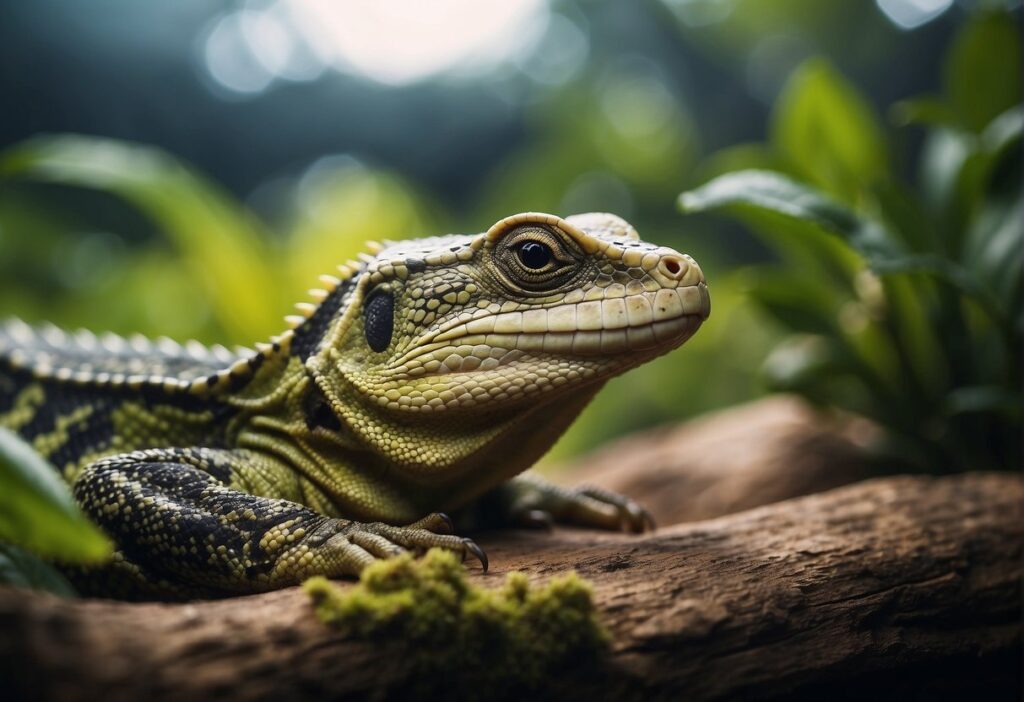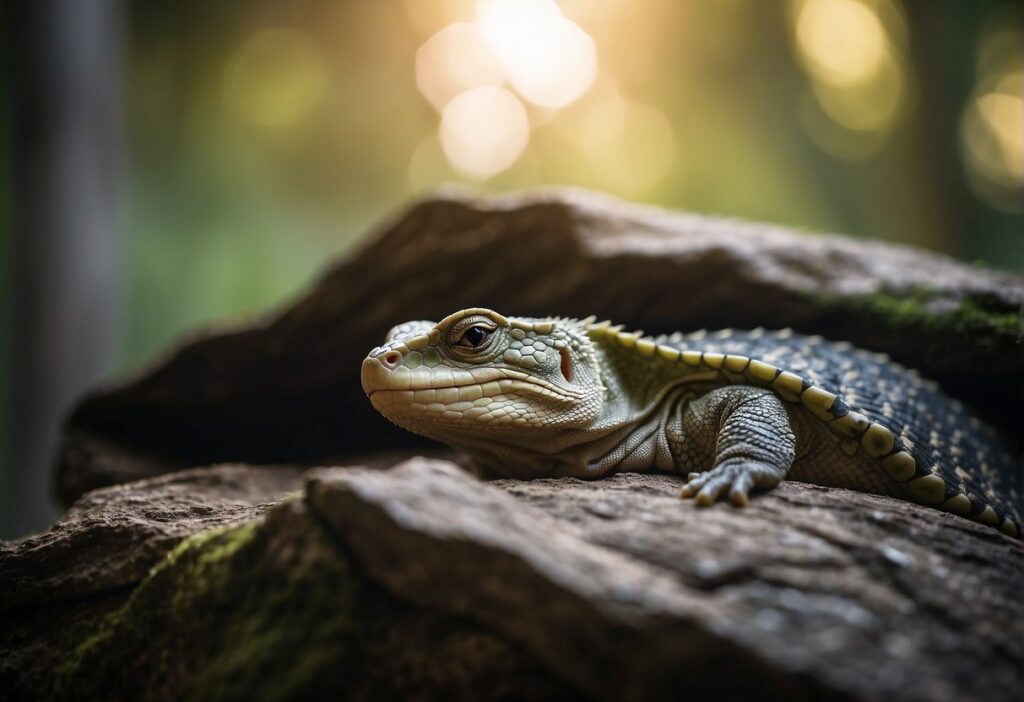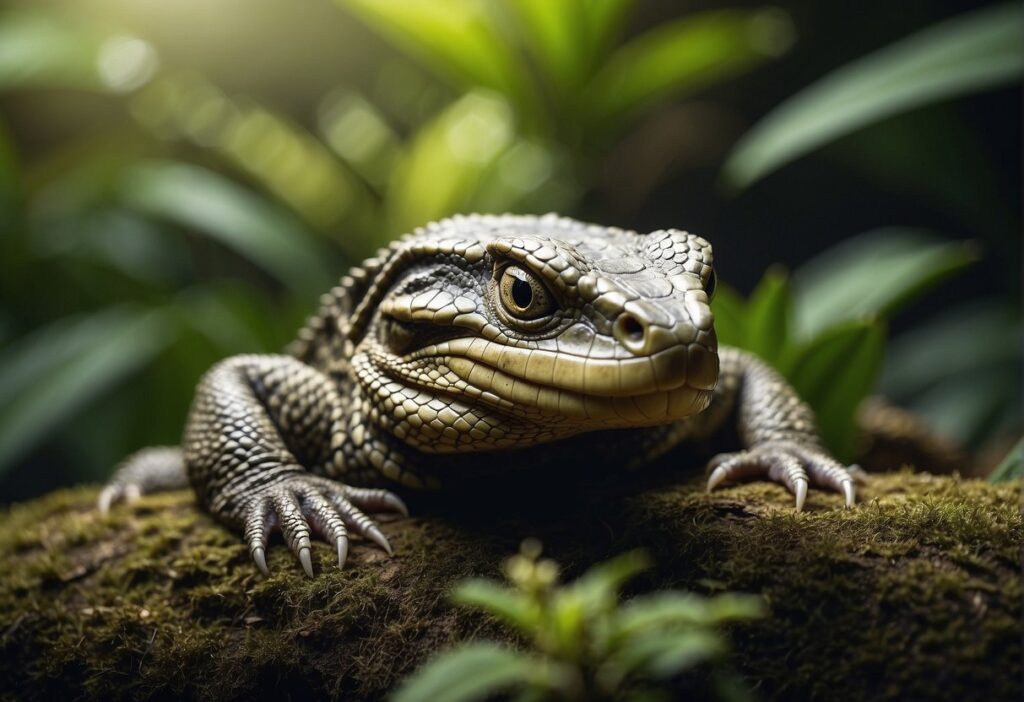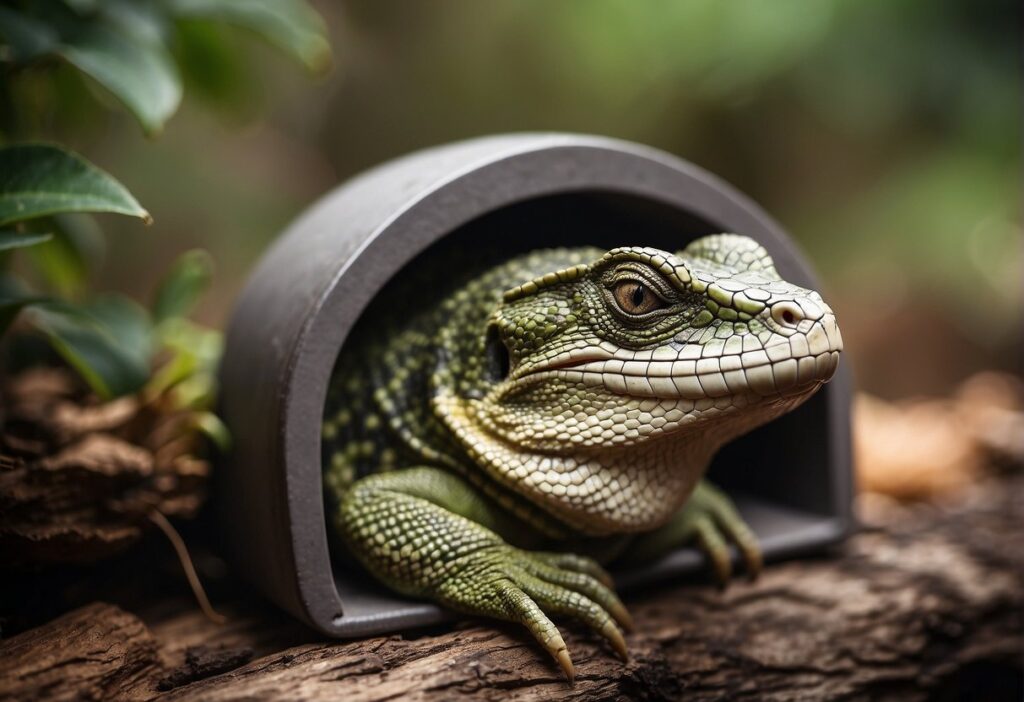Creating a sanctuary for your reptile isn’t just about aesthetics; it’s essential for their well-being and comfort. Reptiles, by nature, seek out hideaways in their habitat as a means of stress relief and self-regulation.
As a dedicated pet owner, it’s your responsibility to mimic their natural environment, providing secure shelters where they can retreat to feel safe, manage their body temperature, and maintain their health.

Crafting these shelters can be a rewarding experience that allows for a personal touch in the design of your reptile’s habitat. From the simple to the elaborate, there are countless DIY ideas to bring naturalistic caves, hammocks, and branches into your reptile’s world. By making these yourself, you not only get to tailor each hide to your pet’s specific needs but also ensure that their living space is unique and engaging.
Incorporating such diverse shelter options isn’t just about fulfilling a basic need for your reptile; it radically enhances their quality of life. Whether they’re basking atop a carefully positioned branch or curled up in a cozy cave, these hideaways offer more than just a place to escape—they become a coveted corner of their very own Hideaway Heaven. Use these ideas to start creating an enriching and secure environment for your scaly friend.
Understanding Reptile Needs

Finding the right hideaway for your reptile friend is essential for their well-being. It’s all about creating a secure space that caters to their instinctual needs for hiding, resting, and regulating body temperature.
The Importance of a Proper Hide
Your reptile relies on hideouts for a sense of security and stress relief. Whether you have a snake or a lizard, a proper hide is non-negotiable. It’s where your pet can escape the outside world and decompress, much like you might retreat to your bedroom after a long day. These shelters are invaluable for thermal regulation, allowing your reptile to cool down or warm up, integral to their physiological health. Depending on the species, certain hides might also aid in the shedding process, a critical aspect of reptile care. For creative ideas on providing these spaces, look to guides for DIY ideas for creating secure shelters for your reptile.
Species-Specific Shelter Requirements
Different reptiles have different needs when it comes to shelters. For example:
- Snakes: They prefer tight spaces that they can squeeze into because it makes them feel more secure.
- Lizards: Many like to have options for basking and cooler areas, leading to a need for multiple hide types.
For a secure and enriching environment, your pet reptile should have access to a hide that reflects its natural behavior patterns. For snakes, it is often a dark, snug hideout to mimic the burrows or crevices they might find in the wild. For arboreal species, they may prefer elevated hides or hammocks. A creative hammock can provide a comfortable resting place for tree-dwelling reptiles, and you can look into reptile hammocks for secure and enriching hiding.
-

Beaded Dragon Fan Exclusive: ‘Original Hipster’ T-Shirt – Wear Your Unique Style with Pride – Unisex t-shirt
£13.00 – £20.50 Select options This product has multiple variants. The options may be chosen on the product page -

Chinese Water Dragon Aquatic Mastery Tee: Dive into Elegance with Our Exclusive Reptile Enthusiast Shirt – Unisex t-shirt
£13.00 – £20.50 Select options This product has multiple variants. The options may be chosen on the product page
Designing the Ideal Hideaway

Creating the ideal hideaway for your reptile promotes their well-being by providing a secure space for stress relief and aiding in essential behaviors like thermoregulation. Let’s get into how you can craft that perfect retreat, focusing on the shape, size, materials, and conditions vital for your reptile’s health.
Selecting the Right Shape and Size
For your reptile to truly feel safe, the hideaway must match their instinctual needs. Start with understanding your pet’s size and behavior. Arboreal reptiles will appreciate vertical spaces, while ground-dwellers need snug horizontal caves. As a rule of thumb, ensure the shelter is large enough for your reptile to enter, turn around, and lay comfortably, but cozy enough to provide a sense of security.
Choosing Safe and Suitable Materials
The health of your reptile hinges on the use of safe, non-toxic materials. Natural materials like half-logs and coconut shells are fantastic options that also lend an aesthetic appeal to the enclosure. For DIY projects, consider using reptile-safe silicone to secure pieces without the risk of harmful fumes. Always make sure the materials you use are free from sharp edges and splinters to prevent injury.
- Recommended Materials: Untreated wood, cork, terracotta, or smooth rocks
- DIY Tip: Hollow out a sturdy piece of wood for a custom-fit cave.
Ventilation and Humidity Considerations
Lastly, ensure your hideaway design does not compromise your reptile’s environmental needs, such as humidity and ventilation. A poorly ventilated shelter can lead to respiratory issues or mold growth. Include small air holes if creating an enclosed space, and use moisture-retaining materials if your reptile species thrives in higher humidity. Balancing the humidity inside the hiding spot with the overall terrarium is crucial.
- Ventilation: Drill small holes for airflow in enclosed hideouts.
- Humidity: Incorporate sphagnum moss or eco earth to maintain moisture levels.
DIY Hideaways on a Budget
Creating secure and comfortable hideaways for your reptile doesn’t have to strain your wallet. With thoughtful planning and resourceful materials, you can build budget-friendly hideaways that cater to your reptile’s need for privacy and comfort. Follow these steps to craft a hideaway haven your pet will love without breaking the bank.
Planning Your DIY Project
Before diving into your DIY hideaway, take a moment to plan. Consider what kind of hide your reptile prefers; whether it’s a cool, dark cave for a snake or a warm, snug spot for a lizard. Measure the space within your pet’s enclosure to ensure the hide fits well and doesn’t overcrowd their habitat. A clear plan will help you create a functional and cost-effective DIY reptile hide.
Upcycling Everyday Items
Look no further than everyday items around your home for upcycling into reptile hides. Containers from food packaging can transform into cozy retreats with just a few adjustments. Here’s a brief list of materials you can repurpose:
- Cardboard boxes: Ideal for temporary hides; remember they are not waterproof.
- Plastic containers: Durable and easy to clean; ensure they have no sharp edges.
- Styrofoam pieces: Can be carved into rocky hides; cover with non-toxic sealant for moisture protection.
Reusing these materials not only saves money but also benefits the environment by reducing waste.
Step-by-Step DIY Reptile Hide
Building a hideout from plastic containers is a simple project that you can complete with minimal tools. Here are concise instructions:
- Select an appropriately-sized plastic container.
- Wash it thoroughly and dry.
- Cut an entryway, sanding any sharp edges for safety.
- Place it in your pet’s enclosure, partly burying it under substrate if you wish to mimic a burrow.
For a more naturalistic look, cover the outside with paper mache and non-toxic paint. Incorporating branches and foliage can enhance the hide’s integration with your reptile’s environment, providing a more enriching setup.
With these steps, you’ll have a functional DIY reptile hide that is both economical and perfectly suited to your pet’s needs.
Enrichment and Decor
Creating an enchanting and stimulating environment for your reptile isn’t just about aesthetics—it directly contributes to their mental well-being. By integrating elements that mimic their natural habitat, you promote a life full of enrichment and offer essential mental stimulation.
Naturalistic Enclosure Setup
Your reptile’s terrarium benefits greatly from a naturalistic design. It means including features that replicate their wild environment. Start with the basics: a variety of substrates to burrow in, rocks to bask on, and multipurpose decor. Aim to provide both secure hiding spots and open basking areas within the enclosure to simulate a natural landscape providing both comfort and stimulation.
Adding Plants and Branches
Incorporating plants and branches transforms your reptile’s space into a truly naturalistic paradise. Plants add both beauty and functionality, offering shaded areas and even more hiding spots. Safe, non-toxic live plants are ideal, but artificial ones can also provide similar benefits without the maintenance. Scatter branches of varying thicknesses to encourage climbing and to facilitate natural thermoregulation behaviors in your reptile.
Customizing with Paint and Finishes
Lastly, bringing your personal touch to the enclosure enhances its appearance and can be very satisfying.
- Opt for non-toxic paints and finishes to add color and vibrancy to the decor elements.
- When decorating, always prioritize your reptile’s safety by ensuring there are no sharp edges or small parts they can ingest.
- Refresh the look of caves and hides by applying safe stain or paint—this allows for a customized habitat that’s visually appealing to both you and your pet.
Remember that any additions to your terrarium should not only be visually appealing but should also contribute to the physical and mental stimulation of your reptile, making their environment richer and more engaging.
Maintenance and Safety

Creating a safe and clean environment is crucial for the well-being of your reptilian friend. Proper maintenance of your DIY reptile hides ensures longevity and promotes the health of your pet by minimizing stress and the potential for illness.
Cleaning and Sanitizing Hides
To prevent bacterial growth and keep your reptile’s habitat healthy, it’s essential to clean and sanitize the hides regularly. Use non-toxic materials for both the construction and cleaning process to avoid harming your pet. For example, a solution of vinegar and water can be an effective and reptile-safe cleaning agent. Simply remove the hides from the enclosure, scrub them with the vinegar solution, rinse thoroughly with water, and let them dry completely before placing them back into the habitat.
Regular Safety Checks
Conducting regular safety checks on your DIY reptile hide is just as important as cleaning. Inspect the hide for any sharp edges, loose parts, or wear that could harm your reptile. If you’ve constructed a hide from natural materials like hammocks or branches, check for splinters or weak spots where your reptile could become trapped or injured. Always ensure that everything within the enclosure is secure and stable to protect your pet from accidents.
Remember, taking the time to maintain and regularly check the condition of reptile hides not only extends their usability but also keeps your scaly companion safe and content.

